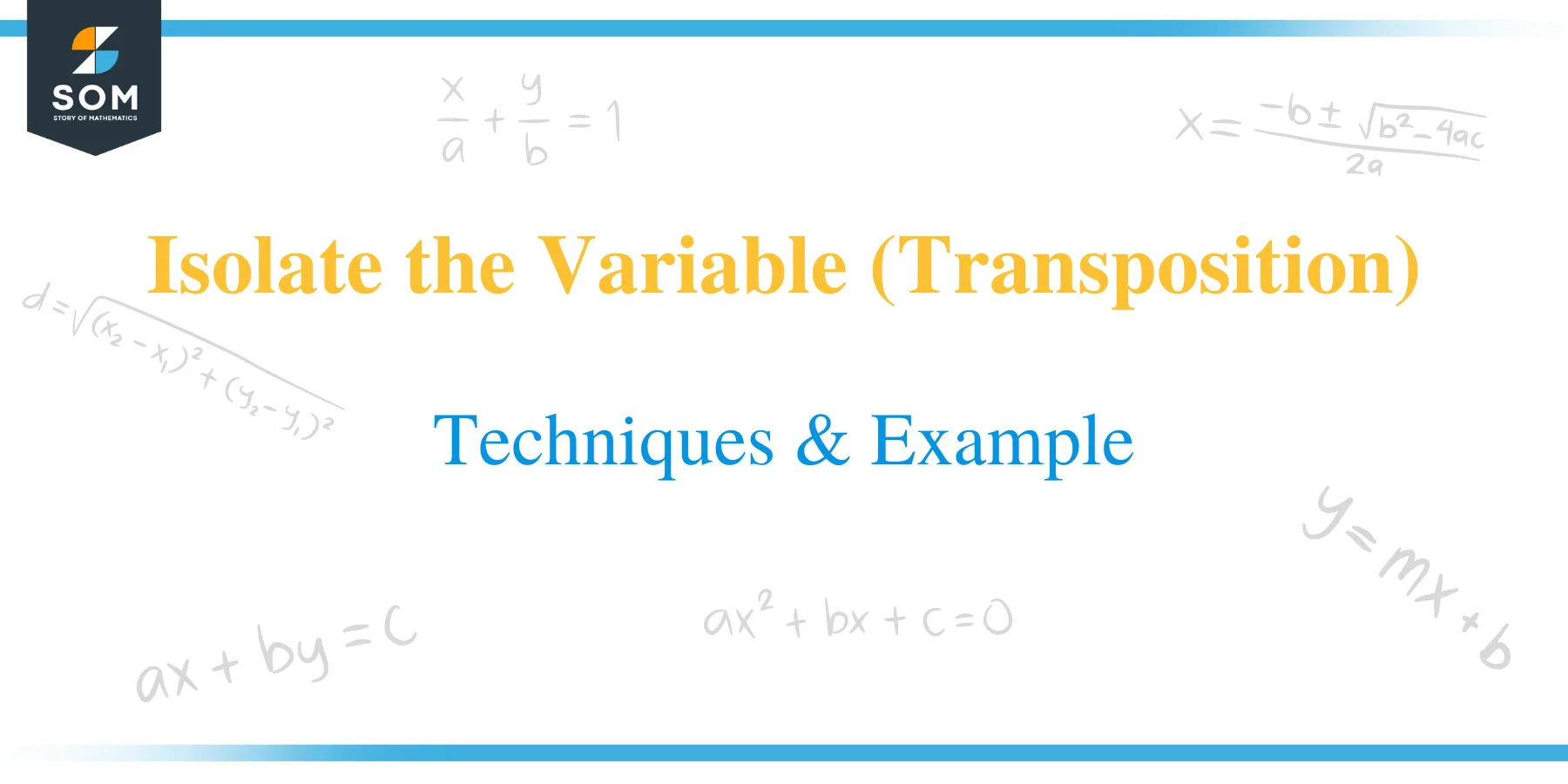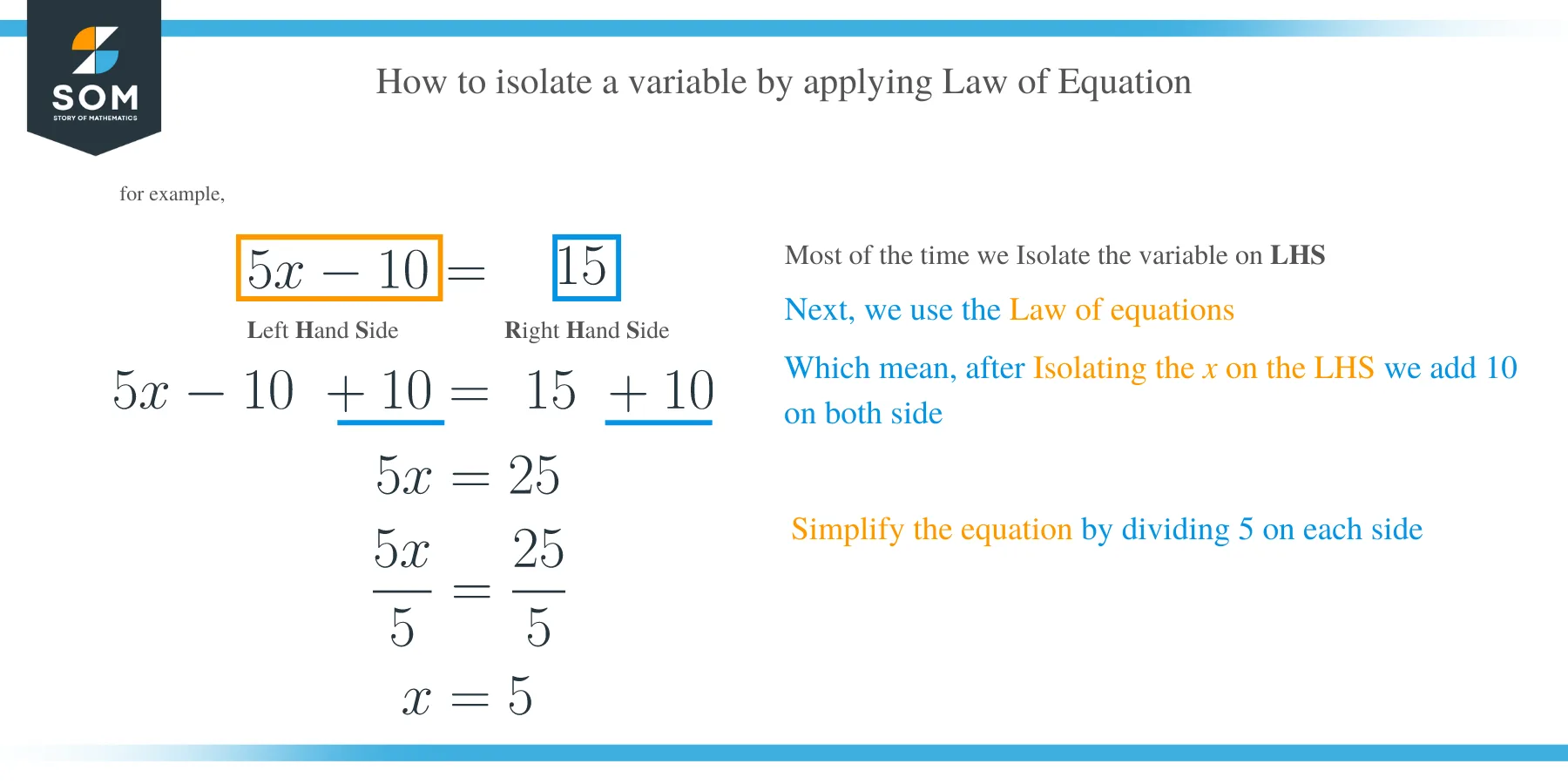- Home
- >
- Isolate the Variable (Transposition) – Techniques & Examples
Isolate the Variable (Transposition) – Techniques & Examples
 Before we can learn about transposition, let’s take a review of what an equation is. In mathematics, an algebraic equation is a mathematical phrase where two sides of the phrase are connected by an equal sign (=).
Before we can learn about transposition, let’s take a review of what an equation is. In mathematics, an algebraic equation is a mathematical phrase where two sides of the phrase are connected by an equal sign (=).
For example, 5x + 10 = 15 is an algebraic equation where 15 represents the right-hand side (RHS) and 5x + 10 represents the left-hand side (LHS) of the equation. The process of isolating quantities across the equal sign of an equation is called transposition.
The isolating variable is an important skill for students to master as they progress from one level of learning algebra to another.
How does transposition work?
Solving an algebraic equation normally moving or isolating the unknown value on one side of the equation, either the LHS or RHS. It is advisable to isolate a variable on the LHS of the equal sign because an equation is generally read from left to right.
Let us also remind ourselves about the Law of equations:
How to Isolate a Variable?
Transposition is a method to isolate the variable to one side of the equation and everything else to the other side so that you can solve the equation.
Algebraic equations can be solved using the Law of equations. The Law of equations states that whatever you do on one side of an equation, you must do on the other side as well.
Let’s see the different examples below to learn how to isolate the given equation’s variables and solve for that variable.
Example 1
2x – 3 = 13
Solution
We can solve this problem by first by applying the Law of Equations;
- Add 3 to both the RHS and LHS of the equation
2x – 3 + 3 = 13 + 3 ===>2x = 16
- Then divide the left hand and right-hand side of the equation by 2;
2x/2 = 16/2
= 8
Alternatively, we can solve 2x –3 = 13 by isolating variables as shown below:
- Move -3 from the left side, over the equal sign, to the right side, and change its sign from “–” to “+.”
- Now we have 2x = 13 + 3, which becomes 2x = 16;
- Divide by 2 on both sides;
2x/2 = 16/2
- Which gives the same answer x= 8, as with the Law of equations.
The beauty of the technique of isolating a variable is that we can visually see how different parts of an equation change as we solve, unlike in the Law of equations where you perform two actions on the right and left-hand side of an equation.
When isolating a variable, we literally pick up the constants and move them to the other side of an equation. You only need to take into consideration the sign of the quantity being moved.
Example 2
Solve 3y + 2x – 3 = 7 for y.
Solution
- Since we want to isolate y, we can transpose 2x and – 3.
- This gives us 3y = –2x + 7 + 3.
- Simplifying, we get 3y = –2x + 10;
- Divide both sides of the equation by 3;
3y/3 = –2x/3 + 10/3
y = (- 2x + 10)/3
Example 3
Solve for x: 2x + 5 = 35 – 4x
Solution
- Add – 4x to both sides of equation;
2x + 4x + 5 = 35 – 4x + 4x
= 6x + 5 = 35
- Now subtract 5 from both sides;
6x + 5 – 5 = 35 – 5
6x = 30
x = 5
Example 4
4x + 3 = 2x +11
Solution
- Subtract 2x from both sides of the equation;
4x + 3 − 2x = 2x + 11− 2x
- Now it looks like any other equation;
2x + 3 = 11
- Subtract 3 from both sides;
2x + 3 – 3 = 11 − 3
- Divide both sides of an equation by 2;
2x/2 = 8/2
x = 4
Example 5
Solve 5x + 7 = 32
Solution
- Subtract 7 from both sides of the equation;
⇒ 5x = 25
- Divide both sides by 5;
⇒ x = 5
Example 6
Solve 3(2y – 12) = 72
Solution
- Start by dividing both sides of the equation by 3;
3(2y – 12) = 72⇒ 2y – 12 = 24
- Add 12 in both sides;
2y – 12 + 12 = 24 + 12 ⇒ 2y = 36
Now divide both sides by 2;
⇒ y = 18
Example 7
Solve 5x + 2x + 14 + 2 = 30
Solution
Combine the like terms;
(5x + 2x) + (14 + 2) = 30
7x + 16 = 30
Isolate the variable by subtracting 16 from both sides;
7x + 16 − 16 = 30 − 16
7x = 14
Divide both sides by 7 to isolate the variable
7x/7 = 14/7
x = 2
How to Isolate a Variable in the Denominator?
To isolate a variable that is in the denominator, you simply cross multiply the equation and collect like terms. Let’s see the examples below:
Example 8
1/(3 x) = 8
Solution
1/(3 x) = 8
Cross multiply;3x * 8 = 1
24x = 1
Divide both sides by 24 to get,
x = 1/24
Example 9
3/x =3
Solution
- In this case x, is the denominator;
- Cross multiply the equation;
3x = 3
- Divide both sides by 3 to isolate x;
So, x = 1
